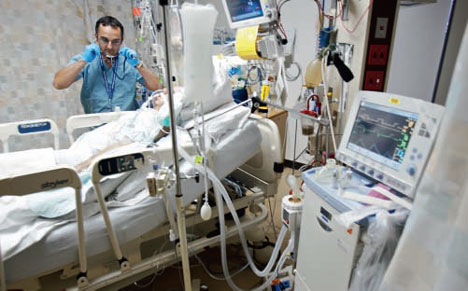5.3 I:E Ratio
Let's review what we know about [latex]\text{I:E}[/latex] Ratio from physiology and apply that to mechanical ventilation. Regardless of what setting the ventilator employs to affect time, it is important to ensure the breath delivery includes adequate time to exhale. Normal inspiratory to expiratory ratios [latex](\text{I:E})[/latex] on spontaneously breathing patients are usually around [latex]\text{1:3}[/latex] to [latex]\text{1:5}[/latex]. Meaning, the ratio of time in expiration is 3 to 5 times longer than the ratio of time in inspiration.
Why do we need longer to exhale than to inhale? If the time to exhale was shortened considerably to the point that you were spending almost the same or more time breathing in instead of out, there would be a risk that you would not have enough time to breathe out fully. You would therefore increase the baseline amount of air left in the lungs before the next breath in.
The [latex]\text{I:E}[/latex] ratio is especially true in mechanical ventilation, as inspiration is an active process of the ventilator pushing air into the lungs, while expiration is a passive act with the normal elastic recoil of the lungs causing the air to flow out of the lungs. If the exhale time continued to remain too short to exhale fully, a small amount of air would continually be added to that baseline amount of air in the lungs before breathing in again. Eventually, your lungs will be too full to take the volume in without reaching dangerously high volumes and high pressures in the alveoli.

The [latex]\text{I:E}[/latex] ratio can be directly affected by the clinician in control modes of ventilation by using I-time or flow, or respiratory rate settings. Let's take a closer look...
Time element of Inspiratory time ([latex]T_i[/latex])
If a shorter [latex]T_i[/latex] or a higher flow is set, the inspiratory phase would be shorter to inflate the lungs to the set amount. For example, if you set the [latex]T_i[/latex] to [latex]0.8\text{ seconds}[/latex] versus [latex]1.2\text{ seconds}[/latex], how would that affect your patient’s [latex]\text{I:E}[/latex] ratio? (Before you look at the answer below, please note that this scenario will assume that the respiratory rate ([latex]RR[/latex]) is maintained at [latex]15\text{ bpm}[/latex]; therefore, each inspiratory/expiratory phase is [latex]4\text{ seconds}[/latex].)
- If [latex]T_i[/latex] is [latex]0.8\text{ seconds}[/latex], then [latex]T_E[/latex] is [latex]3.2\text{ seconds}[/latex]. Therefore, [latex]\text{I:E}[/latex] is [latex]1\text{:}4[/latex]
- If [latex]T_i[/latex] is [latex]1.2\text{ seconds}[/latex], then [latex]T_E[/latex] is [latex]2.8\text{ seconds}[/latex]. Therefore, [latex]\text{I:E}[/latex] is [latex]1:2.3[/latex]
In conclusion, a longer [latex]T_i[/latex] will increase the [latex]\text{I:E}[/latex] ratio, giving more time for inspiration, but less time to exhale. Longer [latex]T_i[/latex] is associated with improvement in oxygenation. However, keep in mind that decreasing [latex]T_E[/latex] may lead to air trapping if not enough time is given for exhalation.
For a good summary of the time element, watch this video:
Respiratory Rate
As the respiratory rate increases, the [latex]\text{I:E}[/latex] ratio increases—more breaths per minute means more of the time ratio spent in the inspiratory phase. This is assuming that the inspiratory time was not changed and that the only parameter changing is respiratory rate. Let’s look at another comparison scenario: an [latex]RR[/latex] of [latex]10\text{ bpm}[/latex] versus an [latex]RR[/latex] of [latex]20\text{ bpm}[/latex] (The [latex]T_i[/latex] is set at [latex]1.0\text{ second}[/latex] for both of these scenarios).
- If the [latex]RR[/latex] is [latex]10\text{ bpm}=6\text{ seconds}[/latex] per total cycle time (TCT), that's inspiratory + expiratory phase. With a [latex]T_i[/latex] of [latex]1.0\text{ second}[/latex], the [latex]T_E[/latex] would be [latex]5\text{ seconds}[/latex]. Therefore, [latex]\text{I:E}[/latex] is [latex]1\text{:}5[/latex].
- If the [latex]RR[/latex] is [latex]20\text{ bpm}=3\text{ seconds}[/latex] TCT, keeping [latex]T_i[/latex] at [latex]1.0\text{ second}[/latex], the [latex]T_E[/latex] would be [latex]2\text{ seconds}[/latex]. Therefore, [latex]\text{I:E}[/latex] is [latex]1\text{:}2[/latex].
In conclusion, a higher [latex]RR[/latex] will increase the [latex]\text{I:E}[/latex], giving less time to exhale.
In order to ensure adequate time for exhalation, the [latex]\text{I:E}[/latex] ratio must be greater than [latex]1\text{:}2[/latex], [latex]1\text{:}3[/latex]. An [latex]\text{I:E}[/latex] ratio less than [latex]1\text{:}2[/latex], [latex]1\text{:}1[/latex], or inverted, such [latex]2\text{:}1[/latex], [latex]3\text{:}1[/latex], refers to more time in inspiration than expiration, which means that air trapping is almost a certainty. Again, air trapping refers to a little extra air remaining in the lungs with every single breath as the lungs do not have time to fully exhale. This remaining air is more than should be left in the lungs with PEEP and it can cause the lungs to inflate more and more, eventually leading to over-inflation and lung damage. Remember, the term air-trapping is referred to as Auto-PEEP.
Conventional ventilation strategies suggest [latex]\text{I:E}[/latex] ratios of around [latex]1\text{:}2[/latex]—meaning expiration should be twice as long as inspiration. Lower [latex]\text{I:E}[/latex]s (shorter [latex]T_i[/latex], longer [latex]T_E[/latex]) could be beneficial in certain pathologies prone to airway collapse, such as some patients with COPD or asthma where the airways may restrict the flow of air going out of the lungs, requiring more time for the lungs to passively deflate. In certain cases where patients are difficult to ventilate, [latex]\text{I:E}[/latex] ratios of [latex]1\text{:}1[/latex] or even inverse ratio are used, with very careful monitoring that gas trapping is not occurring. This strategy will be covered in detail in a later chapter.
"I:E Ratio" from Basic Principles of Mechanical Ventilation by Melody Bishop, © Sault College is licensed under a Creative Commons Attribution-NonCommercial-ShareAlike 4.0 International License, except where otherwise noted.

